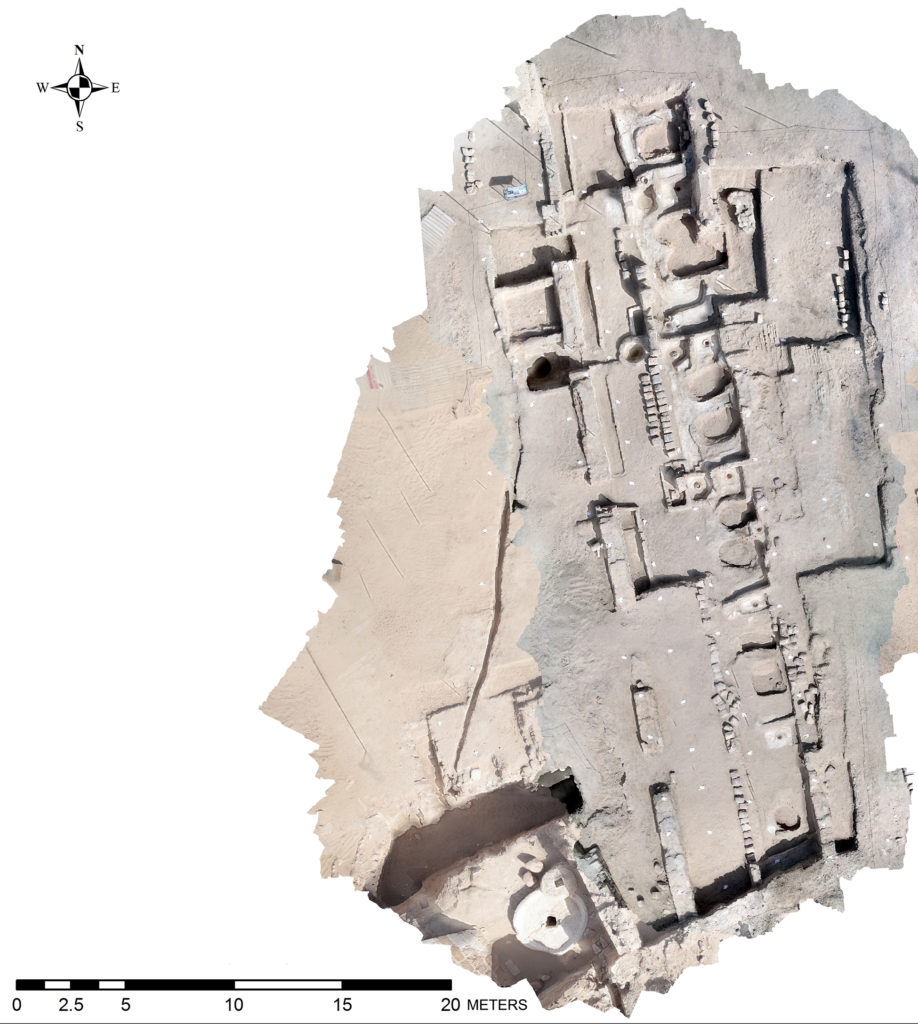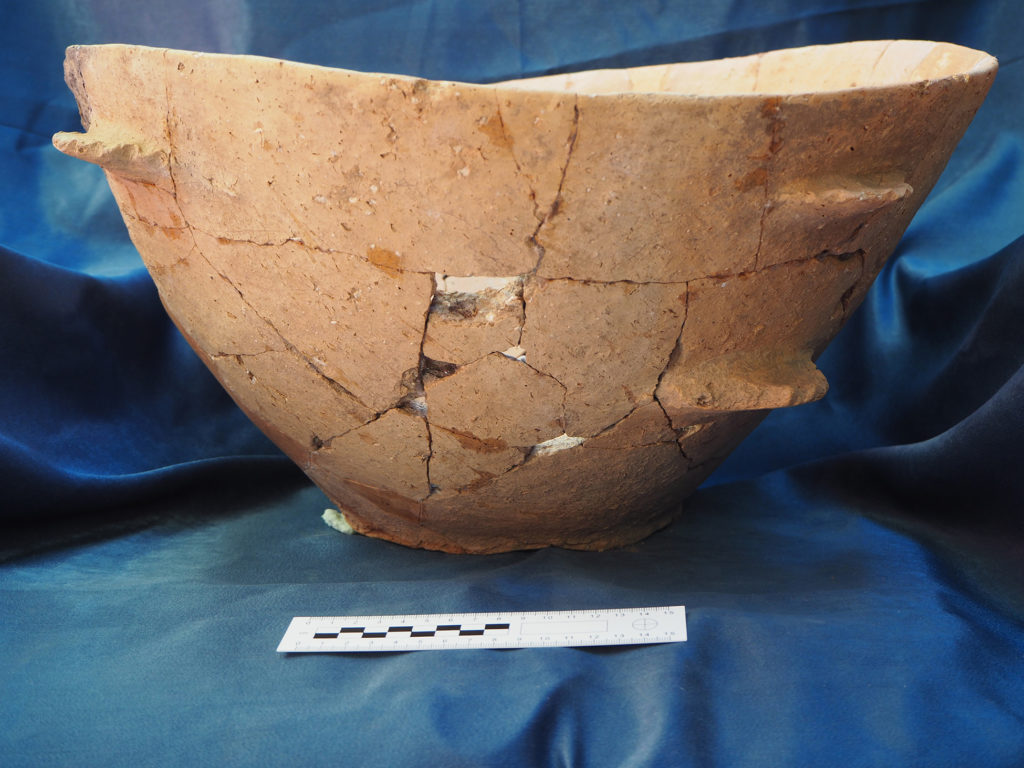In this gallery, we are highlighting results from recent archaeological field seasons through their reports as they appear in Archaeology in Jordan 2 (ACOR, 2020)!
Click the images to enlarge and explore further via the links at left.
The projects covered by AIJ 2 (2018 and 2019 seasons) ask and address exciting questions, test new approaches, and re-evaluate research priorities. Several projects relate experiences with the practical concerns surrounding looting, development, or neglect: for example, salvage/rescue archaeology at Barqa, ‘Ayn Ghazal, the Ghawr as-Safi Project, Khirbat Braq, Murayghat, and Khirbat Al- Balu’a; conservation, re-presentation, and publication of the Nymphaeum in Amman and the Temple of the Winged Lions in Petra; and site recording work on the Karak Plateau.

Aerial view of a historic sugar factory in the Ghor as Safi area. (Composite overhead photo by Q. Dasuqi.) Crystalized sugar was produced here in medieval times by a process of boiling, reducing, and curing. In the latest archaeological field seasons, additional work was done to reveal functioning of the factory in the northeastern areas of the site. New informational site signs were also made by a local ironmonger, and visitor pathways were enhanced. This is not the only place of historical interest in the Ghor as Safi region, which also includes hilltop forts and associated reservoirs, a church, cist graves, and the Museum at the Lowest Place on Earth. In December 2020, a book on the area by Konstantinos D. Politis was published by ACOR, entitled _Zoara, the Southern Ghor of Jordan_. Read more here: https://publications.acorjordan.org/chapters/zoara-the-southern-ghor-of-jordan/ 
Prehistoric chipped stone, possibly late Neolithic, at site LAS 27 on the Karak Plateau, documented as part of a 2018 survey by the Endangered Archaeology in the Middle East and North Africa project (EAMENA). The Karak Plateau includes rapid transitions between multiple environmental zones (agricultural, steppe, desert), facilitating the study of the impact of climate change on Neolithic settlement. Today, the area is increasingly under threat of mining. While many surveys have been conducted in Karak over the years, Neolithic material has yet to be exhaustively explored. (Photo by EAMENA/ Pascal Flohr. EAMENA-20191008-PF-0155.) Find out more here: https://publications.acorjordan.org/articles/late-neolithic-on-the-karak-plateau-2018-2019/ 
Surveys at the site of Murayghat continue partly as a rescue operation, as the construction of a road to the west of the site in 2018 led to the disturbance of several ancient remains. A number of nearly complete broken ceramic vessels, stone tools, and one possible bone tool were excavated from atop an earthen floor. This includes pottery dating to the Early Bronze Age Ia and showing unusual forms, such as the many-handled Murayghat bowl pictured here. The bowl was reconstructed through the ACOR Conservation Cooperative. Find out more here: https://publications.acorjordan.org/articles/murayghat-2018-2019/ 
Thanks to 47 workers, technicians, and experts who contributed to creating this “open-air museum,” the Roman Nymphaeum in Amman was able to officially open to visitors for the first time. New bilingual signage highlights information about the project, site challenges, history and architecture, Nymphaeum hydrology, reinforcement, building materials and marble, site reuse, the Umayyad reservoir, the columns, artistic and aesthetic features, a three-dimensional model for the Nymphaeum monument, and the Roman city urban plan. The project publication has also recently been made available online: openarchive.icomos.org/2351/ (University of Jordan, 2018; photo by Nizar Al Adarbeh.) Find out more here: https://publications.acorjordan.org/articles/amman-the-roman-nymphaeum/ 
Traces of colored stucco floors dating back to the Pre-Pottery Neolithic B period (approximately 8800–6500 BC), uncovered at ‘Ayn Ghazal during emergency excavations in 2019. ‘Ayn Ghazal is considered one of the largest sites from the Neolithic period in the ancient Near East and is located on the main road connecting Amman and Zarqa. It was discovered by chance in 1974 during work to open the highway. The initial archaeological excavations in the 1980s and 1990s revealed the remains of a Neolithic agricultural village that dates back to the second half of the 9th millennium BC and remained populated until the middle of the 6th millennium BC. In August 2019, the Ministry of Public Works and Housing (MoPWH) informed the Department of Antiquities (DoA) of implementation of the Bus Rapid Transit Route (BRT) Project in cooperation with the Greater Amman Municipality, which would take place on the western side of the current Amman-Zarqa highway through the archaeological site of ‘Ayn Ghazal. To establish this BRT route, parts of the site would be destroyed by bulldozers clearing the land to expand the current highway. In response, the DoA partnered with the ACOR Sustainable Cultural Heritage Through Engagement of Local Communities Project (USAID SCHEP) and the MoPWH to conduct rescue excavations at the site, including adjacent to the site entrance, which project experts had identified as rich in archaeological accumulations like this red-painted lime plaster floor. Find out more here: https://publications.acorjordan.org/articles/amman-the-rescue-excavation-project-of-ayn-ghazal-2018-2019 
In 2019, the Balu’a Regional Archaeological Project team returned to the field to continue excavations, and this complete Iron Age pithos was found buried under the floor of a late Iron IIC domestic structure in the area. It was brought to ACOR for restoration by conservation technician Naif Zaban. Research and presentation efforts at the site are ongoing. https://publications.acorjordan.org/articles/khirbat-al-balua-2018-2019/ 
An aerial view of a Bronze Age grave studied by the Barqa Landscape Project in their most recent field season. Excavation revealed that these were stone and mud-brick charnel houses, a style of grave not previously recorded in the Faynan area. Investigation of Bronze Age cemeteries and burials is complicated in this area due to extensive robbing activities over the last thirty years that have left many sites badly disturbed, but this site, Faynan 100, is considered promising. (Photo courtesy of the Barqa Landscape Project.) Find out more here: https://publications.acorjordan.org/articles/barqa-landscape-project-2018-2019/ 
The Temple of the Winged Lions (TWL) is a large sacred complex in Petra with a grand entrance flanked by columns and with an inner cultic chamber featuring a raised podium. The site faces conservation challenges including drainage, monitoring of salts, stability, and long-term conservation and presentation. In 2018, Franco Sciorilli finalized conservation work in the inner sanctuary (cella), and TWL team members completed backfilling in the cella and in the southwest and southeast quadrants. This image from the TWL Cultural Resource Management initiative shows path build-out completed, with course sand added to the bank in front of the cella by team members Shaker AlFaqeer and Ahmad Mowasa and fence posts installed. Best practices for site conservation are still under development, in consultation with Petra community members, while fellows advance study of the site toward final publication, expected in 2022. (March 6, 2018. Photo by TWLCRM Initiative Team.) Find out more here: https://publications.acorjordan.org/articles/petra-temple-of-the-winged-lions-2018-2019/
